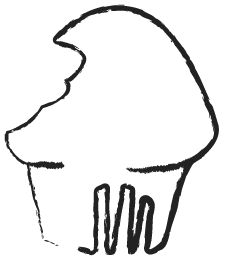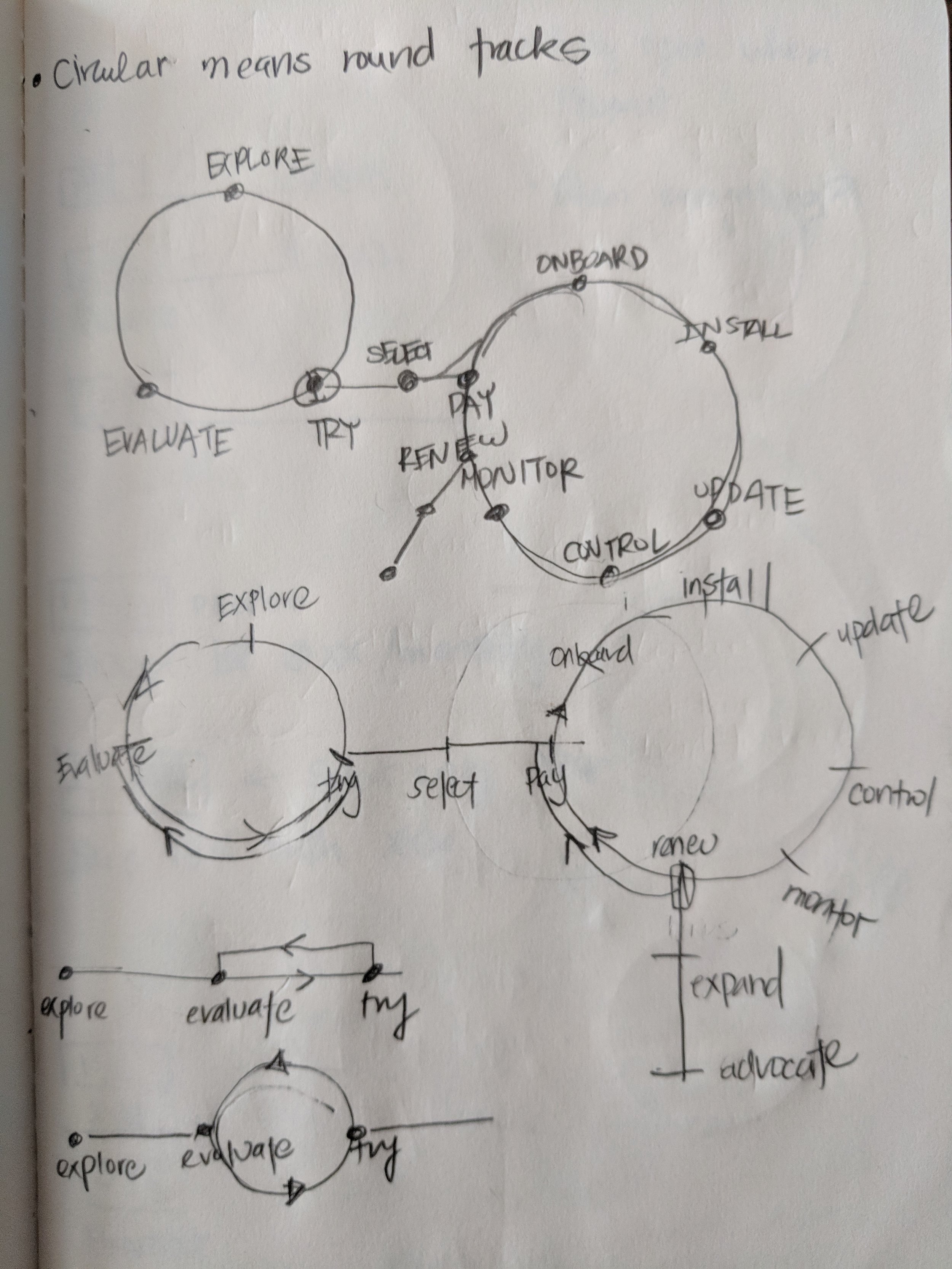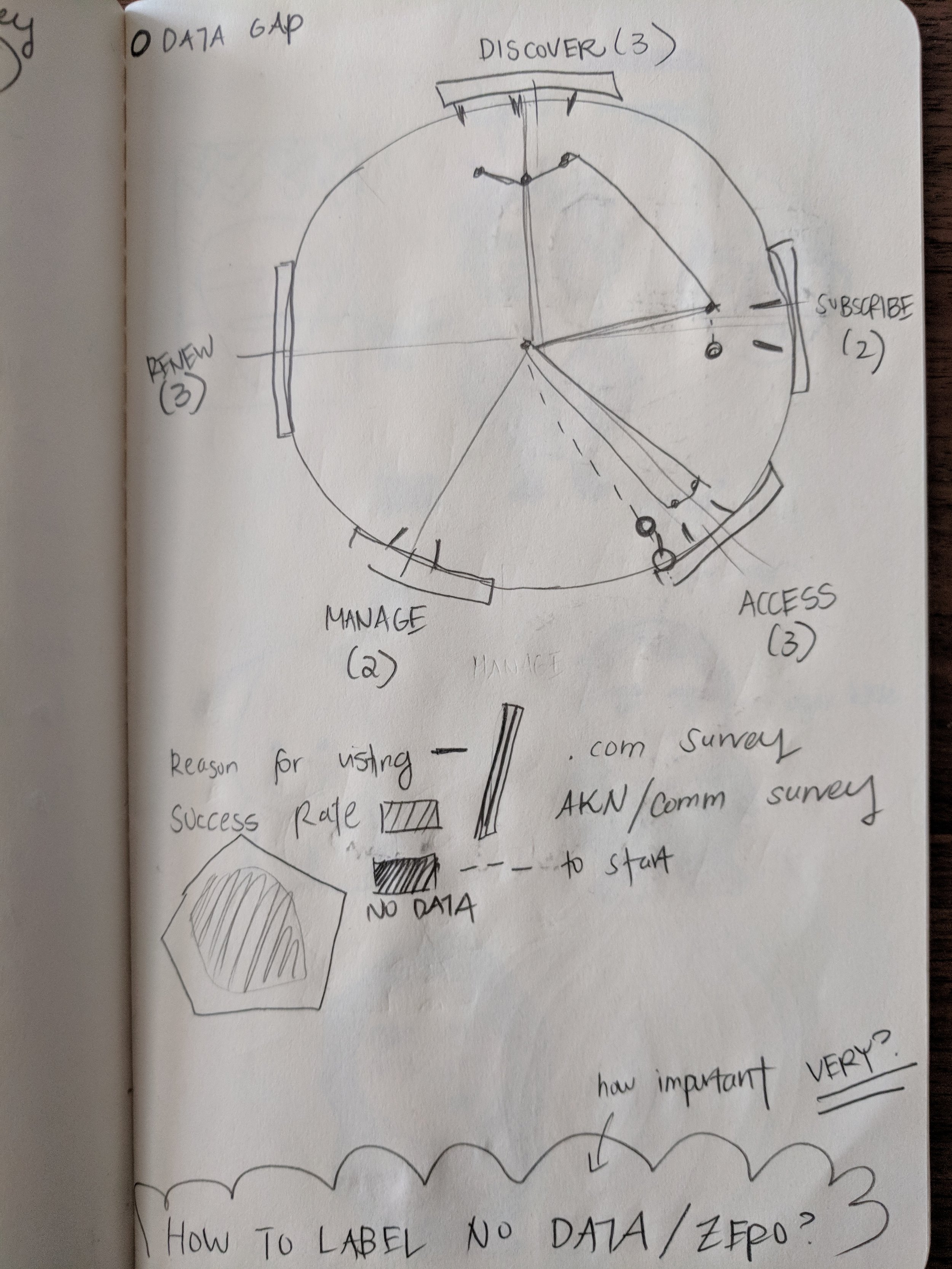A New North Star
In 2018, Autodesk had just underwent a massive company restructuring. The newly appointed design leadership had the unique challenge of establishing a new set of goals: an updated North Star. From a design perspective, the focus was to make Autodesk a uniform, customer-centric company. At the time, Autodesk was a company with siloed teams solving problems independently which resulted in a disjointed experience throughout the customer journey. For example, a user might complete a checkout process for their desired product, then be jarringly shifted to to a payment page managed by a different team who prefers a completely different design aesthetic. These silos were a natural outcome of the company’s history: Autodesk was built through a series of acquisitions, with over 150 distinct products under its umbrella, and components were put together organically as the company grew. Nevertheless, it was time to rethink.
I was selected as part of the core team tasked to take an honest evaluation of the current customer landscape to surface major customer pain points. The original scope was 1 month but quickly expanded to a 3 month project tailing with months of on-going reiterations. The final output was one physical artifact to help teams align goals and efforts based on current customer pain points. The ultimate goal was bettering the customer experience from beginning to end with a fresh design perspective.
The physical artifact served as a successful North Star for the my organization and also the rest of Autodesk. The findings surfaced by the Customer Journey Map project created a massive ripple effect across the company and even gained the attention of the CEO.
* All visuals have dummy text due to proprietary nature of information
STEP ONE
Establish a Brain Collective
For an influential customer map, key stakeholders and clearly defined measurable outcomes needed to be scoped. A project whose main goal was “discovery” has the potential to be unending. To prevent a negative outcome, I helped co-facilitate parts of the workshop to better everyone’s desired outcome & use of the journey map.
Define primary, core team members
Gather the expertise across multiple divisions on all seniority levels
Create buy-in and support of teams & senior leadership
Four LUMA day-long workshops were held to distill the collective wisdom of the senior leadership and product managers. This was the first time I could hear directly from a wide number of teams their roles, pain points and goals. As a designer in a large, global company this was the first time I was invited to think of the business holistically instead of a small portioned piece.
STEP TWO
Visualizing the Customer Journey
The team worked together to narrow down a common language and one common experience an Autodesk customer experience. A large piece of work was breaking down the journey into phases and sub phases leadership and product managers could relate to. Achieving alignment on vocabulary occupied much of the design effort during the first month of the project.
While the loose framework and vocabulary was established, I tackled the arduous task of creating a visual that could capture the lofty concepts. I employed my philosophical and conceptual thinking from my Studio Art school days to pin a nebulous idea into two-dimensional form.
Some key attributes had to be decided…
What is the movement of the customer journey?
What shape does the journey take? Can you shape be readily understandable?
How many phases? Sub-phases?
How much content does / should the map hold? How much is too much information?
I helped narrow down the conceptual thinking to a linear, left to right journey map. This was pivotal as it will not and cannot conceptually capture the many pathways a customer takes. However, it was simple and understandable in one sitting.
Defining notebook scribbles:
The next step was finding a visual, storytelling metaphor to hold the concept neatly. Taking the journey literally, it made sense to map it out like a roadmap or subway network. I drew inspiration from design elements and systems used in existing subway maps. Using a familiar design concept helped new viewers quickly identify and understand what they were looking at.
* Dummy placeholder text due to proprietary information
The customer journey map had to be scannable within the first 3 seconds and still flex to hold more content if someone wanted to drill into the particulars further.
STEP THREE
Define Personas & Terminology
One of the largest challenges was narrowing down the focus to key personas and uniform vocabulary. Autodesk had over hundreds of personas and vocabulary across the company to talk about similar ideas. Through a series of design workshops and crossing data sets, the team narrowed the main customer base to 2 uber personas.
The final outcome was 2 giant flashcard sized persona cards for the team to talk about uniformly with the same terminology and agreed metrics. My other designer counterpart designed and illustrated the personas. We worked together to understand the numbers trapped in Excel sheets and translate them to scannable infographics.
* Dummy placeholder text due to proprietary information
STEP FOUR
Design Rooted in Data
In an engineer driven company, the most convincing argument is always data. The customer journey map, which is highly abstract and complex concept, needed to be grounded with cleanly sourced and annotated data sources. A quarter of the team was responsible for cleaning and re-organizing the data.
More data than we asked for
As the project gained momentum, the data team was able to gather a tremendous collection of insights. It was important to clearly explain numbers as data can be sliced in many ways. At this point the scope of the project extended from 1 month to 3 months and another designer had to be permanently pulled into the core team.
Notably: One visual obstacle was how to represent, annotate and represent unavailable data.
Understanding the much, much bigger picture
As the designer I had to trace and understand the data at every step of the process to define the key metrics, business directives, and customer phases to distill into clear, scannable visuals. This was integral to creating a simple, metaphor to strong high-level concepts together. This flexed new ways of thinking about the business I never had never engaged with previously. It opened my own view and role of design within Autodesk as a bigger company.
STEP FIVE
Surfacing Customer Pain Points
The main objective of mapping out the customer journey is to redefine the various teams’ objectives and help align goals. As the data points both qualitative and quantitative surfaced, customer pain points emerged. These pain points represented areas in the Customer Journey where there was clear opportunity to improve the customer’s experience. The most effective way of communicating theses pain points was through poster sized artifact that could be shared across teams.
Creating this poster became an exercise in stripping the conclusions to bare essentials. Anything that could not be included had to be annotated meticulously. Documentation was key when other teams wanted deeper understanding or had follow up questions.
Successful Company-wide North Star
Once our sum of our findings were pitched to one of the VP’s of Autodesk, it caught wind immediately. Within hours, a copy of the Powerpoint deck was shared with the Autodesk CEO. The following week, a giant poster-sized copy of the Customer Journey Map was posted next to the CEO’s office in San Francisco. Our team was asked to share our findings to teams across the company. For the coming months, a roadshow schedule was set up. The holistic review of the Customer Journey Step was one small and monumental step to align the entire company to the terminology for customer phases, surfaced pain points and major personas from a design-centered approach.
How to relook at the business
For me, it was a great exercise in understanding the entire Autodesk business as a whole translated through the millions of customer touch points. The brainstorm workshops helped me understand the goals of different teams and motives of senior management straight from the source. Admittedly it was vexing at times to comprehend the many business drives, different geo needs and all technological support Autodesk provides at each vertical. It was the first time I sat down and closely analyzed a large, global company from front to end, in and out.
After the project it expanded my understanding of the Autodesk business and helped me bring the Customer Journey map findings to all my other projects.












